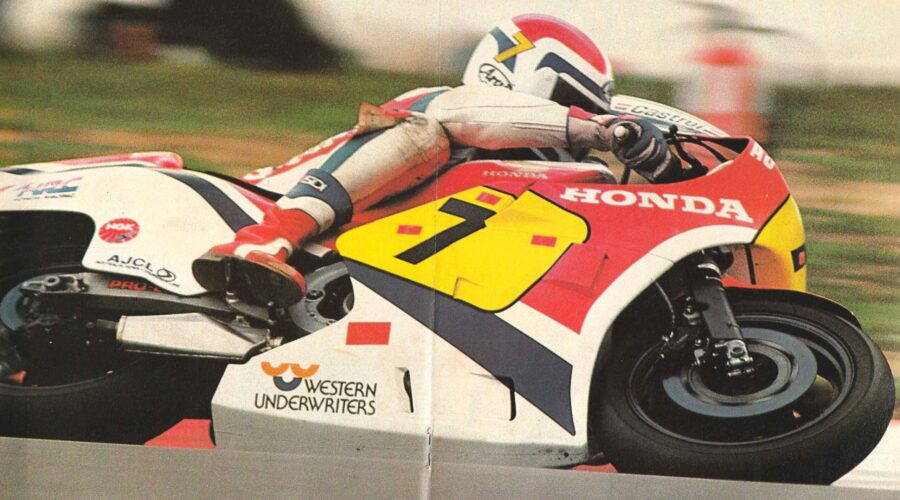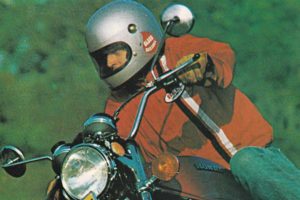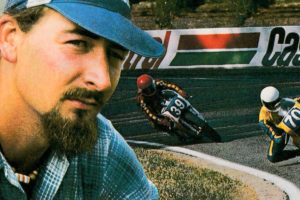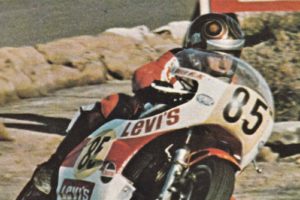Bathurst 1983: Countdown to Glory
Andrew Johnson flops into a metal chair, mopping perspiration from a now ruddy face. His leathers have been shoved down to his waist, revealing damp maroon-toned inner silks. From across the garage, Rob Phillis can’t resist a rival’s jibe.
“How fit are you, Ajay?”
“It’s hot work out there, jumping from one bike to another,” counters Johnson.
And as Phillis well knows, raising a sweat on this, the first day of practice at Bathurst, is hardly likely to faze his chief adversary for Australian 500 Grand Prix honours. For Johnson is now demonstrably fitter than when he dominated the Australian Unlimited Grand Prix, three years earlier.
Bathurst is the meeting Ajay has set his mind on, trained for…primed himself. Others, like Phillis, Paul Lewis, defending champion Ron Boulden and Gary Coleman, have set themselves the same goal. But the overt purposefulness of the 26-year-old bulldozer operator from Melbourne makes this Easter seem like something of a personal crusade.
Not that Johnson’s quest is necessarily self-centred. He also carries the hopes of Team Honda Australia, for he’s riding a brace of expensive machines, including the new Honda RS500R, a replica of the successful NS500 works racers. With just two days testing on the new bike behind him, Andrew concedes that there’s still some sorting to be done, “and this isn’t the place to do it”.
The metal roof of the Marlboro-Holden Dealer Team garage yawns and stretches in the unusually warm Autumn morning. If you wanted a contrast in budget and style, it’s on the other side of the garage, where Phillis is pitted. By his own choice, 27-year-old Rob has brought one mount — the Mick Hone Motorcycles Suzuki RGB500.
Phillis sees his reason for not contesting the Arai 500-kilometre race as straightforward: he doesn’t need another three hours riding time on this circuit, putting himself at risk.
“The last two years in the Arai, something has gone wrong with the bike, and I’ve gone a bit silly trying to make up places. You only need to make one mistake here … ” he notes, with characteristic openness.
In Rob’s pit are his new wife, Carol, and mechanic, Dave “Dragman” McGillivray, who has the Suzuki on very high stands, so he can work standing up. Four metres away, in the depths of the cluttered Honda pit, lanky team manager Clyde Wolfenden mothers the RS500.
Up the hill a little, a large concrete slab and a green tent forms the Toshiba Yamaha Team’s pit. Last year, this team’s forerunner was seen as the big-budget effort. But now, Gary Coleman will tell you, with a hint of dollar-sign envy in his eye, Honda Australia has the big-money title well sewn up.
Coleman is the elder statesman of the 500 contingent. He’s 31, and this is his tenth or eleventh Bathurst. And, while Johnson’s concern is that his mount is so new, Coleman and teammate Boulden are not hiding the fact that technically their TZ500s are at least two years older than the Honda and a year older than the Suzuki RGB.
A few metres away, seated on a cottonreel shaped plastic stool, Warren Willing concentrates on his work. Coleman predicts the Yamahas will run well, “because Warren is still the best guy for preparation; and we have some new parts, like cylinders and power valves.” But the Newcastle rider also makes a concession — that he doesn’t put the same effort into his racing that he did a few years ago.
Teammate Ron Boulden, winner of four Australian grand prix races in the last four years, gives the impression of being free from worry as he chats with members of the Yamaha team’s 12-strong entourage of riders, mechanics, family, friends and employees. But underneath, Boulden and Coleman know they’re facing an uphill slog this time. From the middle of last year it was clear that a well set up Suzuki RGB was faster. And now there’s the Honda, which Warren Willing for one predicted would be impressive.

Youngest of the top five is Paul Lewis. Paradoxically, he shares the greatest number of wins (four) with his immediate senior, Boulden. Lewis is possibly one of the country’s less understood riders. During a race his own level of excitement can sometimes lead to the unexpected. And his lack of weight allows machines to jump around under him on rough circuits.
But with five Bathurst meetings behind him, the bespectacled kid who took up horse riding, then bikes, because asthma wouldn’t allow him to play team sports, regards Mount Panorama as his “home” track.
Thursday afternoon: the shadows are growing cool as the last batch of machines is flagged off the circuit for the day. On the mountain, small clumps of spectators who have had easy access to the prime viewing areas amble back to the pockets of established camps, or head into town. The only sounds are a light rustling in the trees and the occasional brrrap from a four-into-one. And at the deserted police compound, the only serious affront is the department’s architecture …
Down in the pits, the first day of practice is analysed. Phillis and McGillivray are puzzled and concerned because the Suzuki suddenly loses power on Conrod, with one cylinder cutting out. Forty metres away, in an annexe stretched from the Kevin Donnellan Tyres van, Lewis and his tuner George Huse are considering the same problem. Using two pairs of spectacles as a magnifying glass, they examine the spark plugs.
But there’s a second worry. The Suzuki is jumping out of gear; usually the first sign of that RGB curse, the broken gear. One put Paul on his ear in Tasmania a few weeks earlier.
At this stage, Lewis appears to be as fast as anyone. But he and his crew are in for a long night. When the gearbox sump plate is removed, back at their motel, it’s full of alloy. Second, third and fifth gears are broken. Short of spare gears, they’ll work to 4am cobbling up a new set, and for good measure rebuilding the clutch. The result is a box with some odd gaps between ratios.
In a happier mood is Coleman. He’s proved the value of setting up a machine by chopping three seconds off his lap times, thanks to changes in gear ratios, final gearing and power valves. Boulden is also pleased with progress on his 500.
Johnson’s Honda has been running steadily, bit by bit demonstrating its potential. Informed opinion already is that the combination will be hard to beat. But while Ajay aficionados are confident, Johnson himself has gone into what might be termed his “need to be reassured” mode. This may surprise those who see him only from the spectator areas, particularly those who witnessed his assault on the Mountain in 1980. Ajay the rider is confident, aggressive, bloody fast, yet precise — clearly at home at Bathurst. In the pits, however, he’s often a picture of studied nervousness.

Between sessions he goes into huddles with his crew. Wily former racer Tony Hatton is in on these early huddles, too, although his official brief is next door, in the Bennett Honda team tent.
During longer breaks, Johnson goes further afield. He seeks out former riders, or mechanics and journalists he knows, to ask how he’s going! He seeks words with Murray Sayle, who on not being hired as a mechanic for the meeting is enjoying the role as roving consultant.
Ajay wants to know how to combat the tall wheelies he’s pulling on Conrod. Murray says he used to roll off the throttle. “But Warren (Willing) used to touch the back brake,” he adds.
“I can’t react that quickly!” retorts Andrew.
So Sayle suggests trying the left hand side of the track, as towards the edges of the road the camber of the humps decreases.
Next concern is lap times. Ajay figures 2m 19s at this stage is slow, but Murray points out that the 300-plus km/h the team calculates the Honda to be pulling on Conrod (accurate speed trap figures aren’t available) is excellent. With that top speed, he’s sure to end up with fast lap times.
As Ajay exits, Sayle gives a knowing nod: “He just needs reassuring.”
But although anxious about his progress, Johnson permits himself one sweetener. He sits out one round of practice sessions, to save the webbing between his thumb and first finger from blisters. At Bathurst, where practice time is at a premium, skipping a session is a luxury.
Rob Phillis’ face says it all. The first practice session on Friday has brought no improvement in top speed. Near the entrance to the drive-in theatre, the bike simply loses one cylinder.
Rob sits in his folding chair, wearing a fixed stare. In what seems as much a gesture as a concession to tidiness, Dave McGillivray sweeps the floor before wheeling in the Suzuki and commencing work.
At the Lewis camp, however, the night’s work seems to have produced benefits. With a raise of the eyebrows, Paul says the bike is cleaner through the gears and is even pulling wheelies over the humps now! George Huse examines the plugs and pronounces problem solved, saying now they can jet it down some more.
The racer in Lewis is coming out. He knows Phillis is still troubled, and appears to be revising his views of the day before on simply looking for a finish here. When the race nears, racers want to win.
Ajay is still worried. Again he says his times are slow, and he wants to know if the speed trap is operating yet.
The last session before qualifying sees Lewis and Johnson really hitting their stride. At XL Bend the beauty of the RS500’s design is clear as Ajay simply pitches the bike into the corner. It sticks, and rockets out, 88 kW pushing 122 kg, compared with 92 kW and around 137 kg of the Suzuki. But Lewis is unofficially quickest in the session, being timed on the team’s watches at 2m 16.2s — and that despite his feeling the new second and third gear ratios are too high.
Phillis still looks unhappy as he circulates a little later with Ajay and Mal Campbell on their Honda VF860R superbikes in the 2m 20s bracket.
Qualifying is as important to team confidence as much as anything. In Europe, where every lap in a total of two hours official practice is timed, only riders with the best 36 or so times qualify for the race. At Bathurst there are not that many entries. But teams look to the four-lap qualifying session to win a front-row grid position, as well as to establish to both themselves and the opposition that the combination is ready.
With an appropriate sense of tension, the mild day has turned cool, with a chill breeze and disappearing sun.

Johnson’s first flying lap is a 2m 17s. The next has clockers all along pit row turning and showing watches to their neighbours. They read 2m 14s — four seconds under the 500 lap record and half a second off the outright record. Wolfenden decides that’s quick enough and immediately signals Ajay in, but his “slow-down” lap is another 2m 14s.
Back in the garage, sweat in his eyes, left knee padding scraped, brakes stinking of work, Ajay’s heart is still pumping. He tells Clyde he nearly flipped over backwards on the second lap, and that a travelling marshal was in his way on the mountain on one lap. Wolfenden shakes the fuel tank and realises it was just as well the session was brief. The official time is 2m 14.10s.
How did he trim three seconds off his times? More changes to the front end, new tyres and dialling himself up, he says.
Next door, Mick Hone has just arrived from Melbourne, to find an empty pit. Phillis has clocked 2m 15.30s, second fastest time, then run out of fuel at XL Bend. When Rob arrives, he says Ajay is making a second on him on Conrod Straight.
Of the top speed, Rob says it’s okay. On the speed trap’s listings the machine is 8 km/h slower than the Honda and some 4 km/h slower than Lewis and Boulden’s mounts. The problem, it transpires, is due to air currents in the RGB’s fairing. At high speed one of the rear cylinders is starved for air, so the spark plug is momentarily drowned in straight petrol. On the works Suzukis, the problem was tackled with plastic deflector shields, to create a stillair effect.
Team Honda’s solution is to tape the radiator to the fairing, keep to the left hand side of the road on Conrod, and to “pretend” to change gear one more time, by closing and re-opening the throttle.
Paul Lewis, however, has made a slight backward step. The team has been going up and down in jetting, and a move in the wrong direction has seen Lewis qualify at 2m 17.41s. But Paul is a rider who seems to like having something tricky, and now he has it. The top of his seat has a triangular pattern of 2 cm diameter holes. Caught between being secretive andbeing one-up, he says it’s something Italy’s Team Gallina Suzuki discovered to make the machine sit flatter over humps. Compared with Ajay’s mount, it appears to work.
With only two or three laps squeezed into the session, the Yamaha riders have qualified where they expected, at positions four and five, but the times (2m 19s) are a second slower than they did in 1982. It’s been a trying day. At one point Boulden has called it Team Chaos, when in a near comic scene, Coleman’s bike is stuck on its stand, because the stand has been slotted in backwards.
Clyde Wolfenden should be pleased with the new Honda on pole position. But he reserves his judgement, saying he’ll be happy when the race is run. And if two riders and four machines weren’t enough to weigh on him, about an hour later a chance remark is to lead to a unique amalgamation of resources in the M-HDT garage.
At Wolfenden’s suggestion, Johnson has chosen the VF860R superbike over the RS 1000R Formula One/ endurance racer for the Arai.
During a cross-workshop chat, Team Hone gleans this information. So Mick suggests to the others that Robbie should be given a ride. Wolfenden picks up the chorus, and says if they really want to, he’ll check with Ajay and with the Honda Australia execs. Later that night, Johnson says it’s fine, even after Clyde mentions that, “if it stays together, you know it’ll win”.

So on Saturday morning work on the RGB is temporarily suspended, while Rob Phillis wins a race he initially didn’t want to contest, on a Honda. Ironically, it’s Johnson who has the sort of race Phillis has known for the last two years. He finishes second after suffering a flat tyre, warping the brakes with vigorous use, and generally riding hard to make up places, because he feels the crowd wanted to see a race.
Two hours later, the Western Underwriters 1000 is run in conditions which Johnson pin-points as ideal – cool, with a light overcast. It’s the fastest race ever at Bathurst. For nine and a half thrilling laps Johnson and Lewis bobsleigh through the mountain and expresstrain on the straights. Out of some of the slow corners, Johnson can gain ground. But on Conrod Straight, past the drive-in, Lewis can pull in nearly 50 metres — right to his back wheel. Johnson takes the outright record at 2m 13.10s; Lewis does 2m 13.13s.
After seven spine-tingling laps, Johnson has boiled his brake fluid. But Lewis muffs it. On the second last lap he shows his hand at Murrays Corner. On the climb from the Cutting, Lewis is either baulked by lapped traffic or misses a gear, for by Skyline he’s out of reach. An off-line effort at the Esses sees him further behind. But at Murrays he tries something that simply isn’t on.
Instead of second place, $800 and sending Ajay to bed with the knowledge that he’s under threat, Paul treats his brakes and engine to a dose of silicon — in the sandtrap.
Phillis rides a tidy but unenthused race. The bike is a little dull and an experiment with a change of rear tyre brands has produced a nett loss. With Lewis’ misadventure, he picks up second place. Boulden finishes fourth, and Coleman retires with a broken gear lever and a broken water-pump impeller.
It’s to be another long night for Paul Lewis’ crew, rebuilding the engine and brakes, replacing one cylinder, two heads and four pistons. At 7.30 am on Sunday, they’ll be out on a back road, running in the engine.
Sunday afternoon seems to plod towards the start of the 500 Grand Prix. Johnson is a bundle of nerves, pacing up and down the pits. He’s all ready to go long before the official start time, only to find the program running 20 minutes late.
Rob Phillis looks nonplussed, but silent. Carol Phillis feels sick. Dave McGillivray says you never know with Rob, just when he’ll pull the pin. But he doesn’t like racing here. Ajay comes over and they shake for luck. Then Carol gives Rob a hug.

Finally, they’ re called to the grid. Bikes are fired up, they complete the warm-up lap, and the stage is set.
Phillis wins the start, but spoils the advantage by getting sideways on the first corner. Johnson cuts inside and fires into the lead, while Lewis draws up next to Phillis.
The race’s pattern is set in a single corner.
Ajay is a second ahead after one lap, and pulls a demoralising 2.3 seconds out on the next lap. Not looking behind once, Johnson builds his lead until a crash at McPhillamy Park on lap ten partly turns the first three off racing.
Lewis and Phillis duel for second on their Suzukis, neither of which is particularly sharp. It’s a frustrating race for Rob, as his rival has a slight edge in mid-range and just enough in top end to stay ahead on Conrod. On parts of the mountain Phillis feels he’s being held up, but when he succeeds in passing, he makes errors and is repassed.
Stranded at the Cutting by a broken conrod, Gary Coleman watches them slice into the corner and admires Ajay’s smoothness. But it’s a sad end to the weekend for Gary. He wanted to have a good ride in what could be his last meeting on the Mountain.


On the last lap Phillis thinks he has Lewis lined up on Conrod. He pulls to the centre of the road to pass … and promptly loses 30 metres when the aircurrent bogey re-emerges. Paul finishes a sleepless weekend with a second place; Rob returns to the pits annoyed at chances missed, telling Ajay he may go car racing!
Boulden has realised on the first lap that he can’t touch the leaders, so he’s entertained himself and the crowd at the bottom of the Mountain by engaging young Suzuki rider Tony Veitch in a dice and by popping wheelies over the little rise in Pit Straight.

But Ajay is the man. After a big win he has a full-chested, we’re-all-mates-now pride which frankly makes someone in Phillis’ state feel even blacker. As Team Hone removes its pit passes and packs up, Johnson goes onto a well-earned cruise control.
”It was a replay of 1980 — fastest qualifier, a win on the Saturday and a win by 20 seconds in the main race. I even saw a horse in a paddock on Mountain Straight — in 1980 someone sent photos of me to an English magazine with horses in the background,” Andrew explains.
He talks about the bike, Tony Hatton’s and Murray Sayle’s advice, having to look away from crash scenes, about how he and Rob Phillis started their “apprenticeship” as racers together.
“He’s learned more about suspension than I have, but I think I’ve got more determination,” Andrew says.
But perhaps Paul Lewis ties it up for all the Ajay chasers: “I think he wanted it a bit more than I did,” he says, with a half disappointed, half I’m-glad-I-finished smile.
By Don Cox. Pix by Greg McBean. Two Wheels, June 1983.
The ABC covered Bathurst in 1983, and you can watch the video of Johnson’s win in the 500cc Australian Grand Prix here.
Aunty also televised the 250, 350 and Sidecar Grands Prix, the Western Underwriters 1000 and the Arai 500.
And you can hear Robbie Phillis and Mick Hone reminiscing about their racing days in this great podcast from our mates at infomoto.com.au





